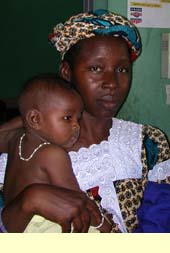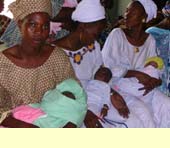
Advocacy to End Female Genital Cutting
“I am grateful for this training, for without it I would have committed a terrible injustice against my niece. Instead, I will now work toward ending female genital cutting in my community.”
At the end of a six-day training workshop on complications from female genital cutting, Dr. D, a physician at the Sikoro health center in Bamako, Mali, made a confession. Before leaving home for the workshop he had agreed to arrange for the genital cutting of his brother’s two-year-old daughter upon his return. But what he had seen and heard in the workshop had caused him to change his mind about the traditional practice.
“PRIME II’s training opened my eyes,” says Dr. D. “I have seen patients with the gynecological and obstetric complications we learned about this week, but I never made the connection with female genital cutting. I now realize that many of the slow and difficult births in my center are due to scarring from female genital cutting that reduces the elasticity of the vagina, making birth dangerous for both mother and child.”
In Mali, 92% of women have undergone female genital cutting. Most are excised before reaching the age of five, following the cultural belief that removal of the clitoris, and sometimes other parts of the female genitalia, will keep a young girl chaste and improve her chances of finding a good husband. In addition to increasing the potential for complications during birth, the negative health consequences of the practice can include hemorrhage, HIV infection, infertility and death.
Although eliminating female genital cutting may be seen as a clear-cut issue of human rights and gender violence, efforts to eradicate the practice must take into account the complex social, cultural and even economic issues that surround it. The continued strength of deeply rooted customs encourages parents to seek out and pay excisors—usually older women—for the service. And while political will against female genital cutting is strong in Mali, public campaigns that emphasize the health risks have contributed to increased medicalization of the practice by health professionals.
Working in the context of broad-based efforts to eliminate female genital cutting in Mali, the PRIME II Project has assisted the Ministry of Health in developing and field-testing a national female genital cutting curriculum to expand the role of primary providers in prevention and managing complications. The Project helped nongovernmental organizations conduct more than 700 community outreach sessions in Koulikoro and Bougouni districts and Bamako Commune I, and partnered to produce a video on the practice that has been distributed to government ministers, members of parliament and mayors.
At 27 health centers in the three PRIME II implementation areas, 120 providers have increased their knowledge and skills related to female genital cutting and are now three times more likely to ask pregnant women if they have complications that might affect birthing. While counseling on female genital cutting was virtually nonexistent at baseline, an end-of-project review of health center registers showed that 414 female clients received private counseling about the practice. Nearly three quarters of providers passed the counseling skills performance test, up from 12% at baseline, and the improved counseling also paid off in a dramatic increase in educational sessions on reproductive health topics in general. Providers facilitated 473 education sessions on the negative health effects of female genital cutting and 958 men participated in waiting-room education. At the end of the year-long intervention, the number of clients who said they were in favor of eliminating female genital cutting had doubled, from 44% to 89%. The percentage of clients who intended to excise their daughters declined to 52% from 70% at baseline.
Dr. D put his newfound beliefs into action when he and the Sikoro health center staff hosted a female genital cutting awareness day for opinion leaders in Mekinsikoro, the oldest neighborhood of Bamako. The participants included griots, religious leaders, teachers, journalists, and the heads of women’s and youth associations. “It was once unimaginable that we could organize an event to talk about female genital cutting,” said one griot. “But we did it. And what an event it was. Every layer of society was represented.”
As the discussion in Mekinsikoro showed, providers like Dr. D can be especially convincing advocates for changing beliefs about harmful practices. “I was reluctant to attend at first,” admitted an advisor to the village chief. “Now I am so convinced of the negative effects of female genital cutting that I would like to be one of the community educators for the project. I want to help spread the message.”
The PRIME II Project, funded by USAID and implemented by IntraHealth International and the PRIME partners, works around the world to strengthen the performance of primary providers as they strive to improve family planning and reproductive health services in their communities.
PRIME Voices #23, Mali: Advocacy to End Female Genital Cutting, 10/13/03.
|












